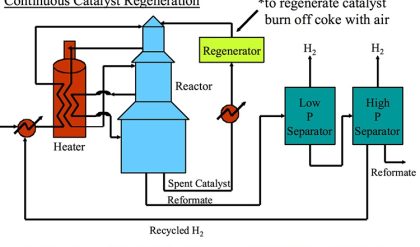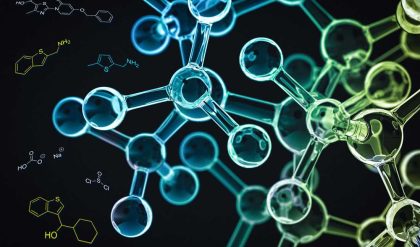Cracking is a process in which large hydrocarbon molecules are broken up “cracked” into smaller, more valuable hydrocarbon molecules. As the name implies, the catalytic cracking process takes place in the presence of a catalyst. The catalyst promotes breaking of the large molecules in a certain way that maximizes the yield of gasoline. Ideally, all of the “cat-cracked” product would be in the gasoline range, but the technology is not that capable. Cat cracking produces a full range of hydrocarbons, from methane to residue.
The feed to the cat cracker is typically gas oil or naphtha. The trend in the design of modern cracking units is the ability to include the residuum as a part of the cracker feed. The residue produced by the catalytic cracker is recycled back into the feed stream. This recycling of the residue is called “recycling to extinction”.
Catalytic cracking consists of three major processes:
· Reaction
· Regeneration
· Fractionation
In the reaction step, the hydrocarbon feed is contacted by the catalyst at a high temperature (about 900 F, 482 C) and the cracking reaction takes place. During cracking, coke is formed. The coke will coat the catalyst preventing it from promoting the cracking reaction. The catalyst is renewed by burning off the coke deposits from the catalyst surface during regeneration. The cracked hydrocarbons are separated using conventional fractionating equipment.
There are three basic types of catalytic crackers:
· Fluid bed
· Moving bed
· Fixed bed
The names of the catalytic cracker styles describe the catalyst bed used. Fluid bed catalytic cracking (FCC) is the most popular design in use today. In the FCC unit, the catalyst is a finely divided powder. When the catalyst is fluidized or “fluffed-up” with air or hydrocarbon vapor it behaves like a fluid and can be moved through pipes and valves.
The catalyst in a moving bed catalytic cracker is in the form of beads or pellets. A mechanical means must be used to move the catalyst from one part of the process to another. In newer plants, air (lift air) or combustion gases from the catalyst regeneration are used to move the catalyst from one place to another.
In FCC and moving bed cracking, catalyst is regenerated in an area separate from the reaction. The catalyst has to be moved by some means from the reactor to the regeneration area. In fixed bed designs, the catalyst is not moved. The equipment consists of a series of reactor vessels containing the catalyst bed. Some of these reactors will be on-line producing cracked hydrocarbons while others will be off-line having the catalyst regenerated.



Comments are closed.